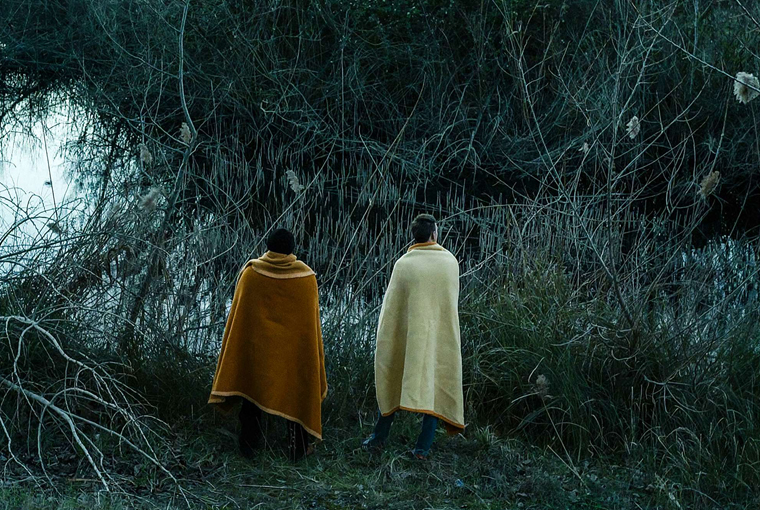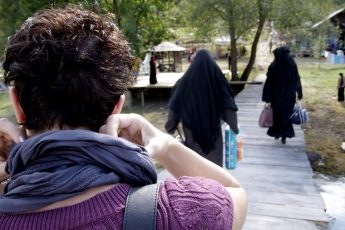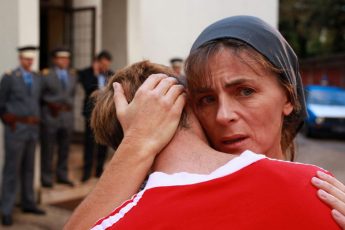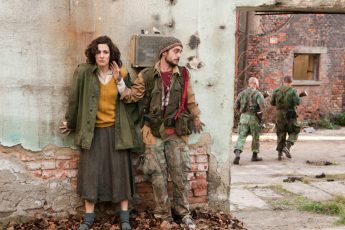How to Cohabit?
Dane Komljen’s All the Cities of the North (Svi severni gradovi, 2016)
Vol. 74 (April 2017) by Rohan Crickmar
All the Cities of the North, Dane Komljen’s debut feature, is a film of quiet, rapturous beauty and beatific calm. Using the form of the docu-drama Komljen has crafted an elegiac film that is determined to find an answer to the question: how to cohabit? Infused with the critical approaches of Jean-Luc Godard and Simone Weil, and utilizing the photography of former Energoprojekt architect Zoran Bojović, the film is a profound meditation on human habitations, love and interconnectivity. For me, it was also the standout film from the eighteen, or so, I saw at IFFR 2017.
Sleeping in tents. Eating berries straight from the trees. Wandering seemingly derelict building sites. Doing laundry in a basin of water. Pissing against a wall. Gently tending to free roaming animals. These are some of the activities that Dane Komljen opens his debut feature with, succinctly foregrounding the quiet passage of time in an unusual, and unusually intimate, male community of two. Ostensibly All the Cities of the North is a film about two men (Boban Kaludjer and Boris Isaković), who are living a tranquil existence together in an old, abandoned holiday complex somewhere along the Montenegrin border with Albania. These two men have found a simple way to exist, repurposing their environs to accommodate their basic requirements. The uncomplicated life that they lead is momentarily disrupted by the arrival of a third man (Dane Komljen), who has brought a film production with him. Boban and Boris try to accommodate this outsider presence, whilst protecting the serenity of the little world they have created for themselves.
Meditatively paced, All the Cities of the North shows itself to be as concerned with its location, as with its two central characters. Through a series of voiceover digressions and photographic inserts, it becomes apparent that the architecture of a space is crucial to Komljen. The place that Boban and Boris inhabit is a holiday complex in keeping with the state-built structures of Socialist Yugoslavia. The fact that the complex is incomplete, at points resembling a building site, hints at the political disruption that probably saw the building project falter and then fail. An abandoned, uninhabited space has been made habitable by the diligent co-operation and teamwork of the two men. Its original purpose has been subsumed by a practical reappropriation.
Parallels are found for this activity of reappropriating built structures in the histories of Zoran Bojović’s international architectural projects for the state-run Yugoslav construction company Energoprojekt. In Lagos, Nigeria, Energoprojekt helped to construct a business complex for an international trade fair during the 1970s. The resulting structures were never used for this purpose, however. Komljen puts forward that such ‘white elephant’ works of architecture have since found alternate usages, very often defined by their conversion into makeshift homes for communities of local people who can make habitable living quarters from these abandoned structures. The film also dwells upon the fate of the workers’ village of Villa Amaury, that was created during the construction of Brasilia, but then submerged under the artificial lake, Lago Paranoá. Komljen has worked on this subject before in his short film (co-directed with James Lattimer) entitled All Still Orbit (2016). A significant section of All the Cities of the North dips under the surface of the water to explore the ghostly remnants of a place that is both present and absent.
It is particularly interesting to see how Komljen uses quotation from the work of Simone Weil, as it seems to further elucidate the constellation of felt thoughts and imaginings that swarm around All the Cities of the North’s every frame. On the one hand the director is clearly interested in the idea of the overlay, something which adapts and modifies. Yet, simultaneously, the film dwells upon images of abandonment and absence. There is undoubtedly something of Weil’s understanding of Platonic ‘metaxu’ present in this tension between connectivity and separation (overlay and absence), and Komljen’s film is peppered with moments that seem to imply connections over great distances, different time periods and despite immediate physical barriers. The film vacillates between macrocosmic and microcosmic foci, seeking to relate a delicate study of love, intimacy and cohabitation, to a larger series of concerns with interstitial and palimpsestic places and structures (architectural and geographic renderings of cohabitation).
What is undoubtedly so arresting about Komljen’s work is the way he grounds his more abstract themes and interests in an extremely tactile and intimately felt formal construction. I struggle to recall a film in which direct, physical human contact felt so vital. Komljen tends to construct sequences around wide shots of the men carrying out activities in the complex, followed by medium shots of their individual pursuits, and then a series of close-ups of bodily contact that focuses attention on the contact rather than the who, what and where. In one sequence the older of the two men has worked the site all day long, and on returning to his make shift tent structure within one of the buildings of the resort he receives a massage from the other man. Komljen’s attentiveness to the actual act of massage, rather than the faces of the men, intensifies the intimacy and tenderness of this action. It is both a gift and an erotically charged gesture, laden with a hidden history. As viewers, we are being invited to see a little of that hidden history, just enough to feel the realm of the private begin to envelope our senses. The unhurried nature of Ivan Marković’s cinematography enhances Komljen’s intimate approach, as the measured motions of the camera and the frequently balanced composition of each shot create a calm and beatific atmosphere, perfect for a meditative or contemplative reception of Komljen’s poetic collisions of ideas.
My favorite example of Komljen’s aesthetic in the film is a sequence that involves the cooking of potatoes. The two men are sat outside at night cooking potatoes over an open fire. The firelight and shadow play off of their bodies in a way that suggests a twinning, as if their dark and light parts are comingling in a collusion of selves. In an effort to hasten the cooking of the spuds, the men rake over the embers of the fire, blowing upon them to reignite the hottest flames. By foregrounding this willing of an ever greater, deeper and more intense heat, Komljen locates a passion that lies in the fire between these two men, that both of them carefully tend.
As much as visually Komljen looks for compositions that bring the men together in intriguingly intimate ways, separation plays a crucial formal structuring role within the film, best exemplified within the sound design. There is no dialog in the film. All verbal communication is restricted to a multi-character voiceover. The ambient sounds within individual scenes are frequently isolated and intensified by sound designer Igor Camo. This is most obviously demonstrated in a scene in which one of the men cuts the other’s hair. The sound capture is so crystal clear that you can hear the fiber of each hair rending. Also, what would normally be background noise is enhanced and frequently used to underscore the film’s dislocation of sound and vision. At times, it is as if Komljen is displaying parallel films, one comprised of visual information, the other comprised of aural information. Before the emergence of the third man – played by Komljen himself – there are scenes in which the two cohabitees of the complex lie about in seemingly blissful peace and quiet. Yet, these scenes are incongruously soundtracked by the noises of a playfight, or the percussive rhythm of feet running up and down a staircase. Where the sound design works to merge things together is in the way in which it mixes voiceover passages from the Slavic tale of Prince Marko, as well as lines of dialog from Jean-Luc Godard’s 1982 film Passion and Simone Weil’s philosophical notes on the human relationship to God as published in Gravity and Grace. This is done in such a way as to make it seem like a carefully composed monologue, the shared thoughts and musings of the two men.
As much as Komljen’s thinking is very clearly global, at its core the film has the lost idea of Yugoslavia as its ur-text. The personal relationship of the two men, and the way in which they accommodate Komljen’s filmmaker, has the clear potential to be read as an allegory of Yugoslav unity. Even the location of the resort site caught between Montenegro (a part of Yugoslavia) and Albania (that state that remained beyond and outside of Yugoslavia) is suggestive of a greater conciliatory desire. It is also telling that Komljen moves the film outside of the Balkans by using the Yugoslav construction company of Energoprojekt – Lagos approached through the prism of state Socialist Yugoslav architecture and city planning. At the close of the film Komljen cuts harshly from a ghostly dreamlike vision of skeletal plants drifting up through the night, to the black of the end credits, with a musical cue coming in the form of a song from the Yugoslav new-wave band Idoli, called ‘Ime da da’. The sound of this song and its lyrical content about catching hold of what has gone for one last time, act as a poignant marker of how life is really a perpetual struggle to adapt and to move on, but to still somehow keep hold of an essence of what once was good, and what once gave meaning and hope.




Leave a Comment